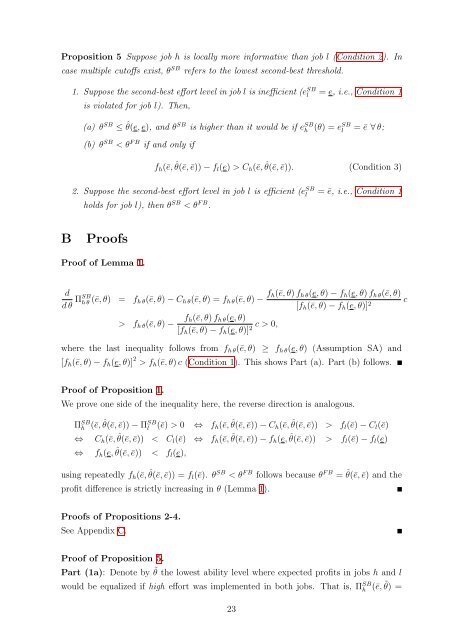Job Assignments under Moral Hazard - School of Economics and ...
Job Assignments under Moral Hazard - School of Economics and ...
Job Assignments under Moral Hazard - School of Economics and ...
Create successful ePaper yourself
Turn your PDF publications into a flip-book with our unique Google optimized e-Paper software.
Proposition 5 Suppose job h is locally more informative than job l (Condition 2). In<br />
case multiple cut<strong>of</strong>fs exist, θ SB refers to the lowest second-best threshold.<br />
1. Suppose the second-best effort level in job l is inefficient (e SB<br />
l<br />
is violated for job l). Then,<br />
= e, i.e., Condition 1<br />
(a) θSB ≤ ˆ θ(e, e), <strong>and</strong> θSB is higher than it would be if eSB h (θ) = eSB l = ē ∀ θ;<br />
(b) θ SB < θ F B if <strong>and</strong> only if<br />
fh(ē, ˆ θ(ē, ē)) − fl(e) > Ch(ē, ˆ θ(ē, ē)). (Condition 3)<br />
2. Suppose the second-best effort level in job l is efficient (e SB<br />
l<br />
holds for job l), then θ SB < θ F B .<br />
B Pro<strong>of</strong>s<br />
Pro<strong>of</strong> <strong>of</strong> Lemma 1.<br />
= ē, i.e., Condition 1<br />
d<br />
d θ ΠSB h θ (ē, θ) = fh θ(ē, θ) − Ch θ(ē, θ) = fh θ(ē, θ) − fh(ē, θ) fh θ(e, θ) − fh(e, θ) fh θ(ē, θ)<br />
[fh(ē, θ) − fh(e, θ)] 2 c<br />
> fh θ(ē, θ) − fh(ē, θ) fh θ(e, θ)<br />
c > 0,<br />
[fh(ē, θ) − fh(e, θ)] 2<br />
where the last inequality follows from fh θ(ē, θ) ≥ fh θ(e, θ) (Assumption SA) <strong>and</strong><br />
[fh(ē, θ) − fh(e, θ)] 2 > fh(ē, θ) c (Condition 1). This shows Part (a). Part (b) follows.<br />
Pro<strong>of</strong> <strong>of</strong> Proposition 1.<br />
We prove one side <strong>of</strong> the inequality here, the reverse direction is analogous.<br />
Π SB<br />
h (ē, ˆ θ(ē, ē)) − Π SB<br />
l (ē) > 0 ⇔ fh(ē, ˆ θ(ē, ē)) − Ch(ē, ˆ θ(ē, ē)) > fl(ē) − Cl(ē)<br />
⇔ Ch(ē, ˆ θ(ē, ē)) < Cl(ē) ⇔ fh(ē, ˆ θ(ē, ē)) − fh(e, ˆ θ(ē, ē)) > fl(ē) − fl(e)<br />
⇔ fh(e, ˆ θ(ē, ē)) < fl(e),<br />
using repeatedly fh(ē, ˆ θ(ē, ē)) = fl(ē). θ SB < θ F B follows because θ F B = ˆ θ(ē, ē) <strong>and</strong> the<br />
pr<strong>of</strong>it difference is strictly increasing in θ (Lemma 1).<br />
Pro<strong>of</strong>s <strong>of</strong> Propositions 2-4.<br />
See Appendix C.<br />
Pro<strong>of</strong> <strong>of</strong> Proposition 5.<br />
Part (1a): Denote by ˜ θ the lowest ability level where expected pr<strong>of</strong>its in jobs h <strong>and</strong> l<br />
would be equalized if high effort was implemented in both jobs. That is, Π SB<br />
h (ē, ˜ θ) =<br />
23
















